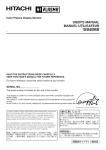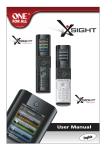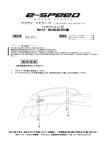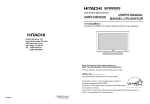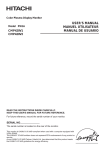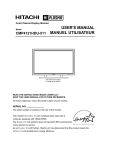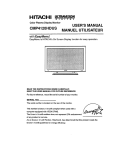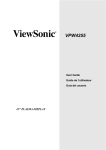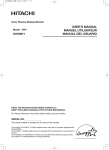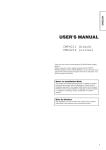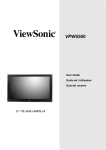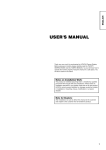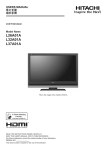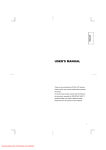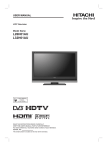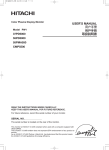Download USER`S MANUAL
Transcript
ENGLISH USER'S MANUAL Thank you very much for purchasing the HITACHI Plasma Display Monitor. Before using your monitor, please carefully read the "SAFETY GUIDELINES" and this "USER'S MANUAL" so you will know how to operate the monitor properly. Keep this manual in a safe place. You will find it useful in the future. Notes on lnstallation Work: This product is marketed assuming that it is installed by qualifed personnel with enough skill and competence. Always have an installation specialist or your dealer install and set up the product. HITACHI cannot assume liabilities for damage caused by mistake in installation or mounting, misuse, modification or a natural disaster. Note for Dealers: After installation, be sure to deliver this manual to the customer and explain to the customer how to handle the product. FEATURES Large-screen, high-definition plasma display panel The 42-inch color plasma display panel, with a resolution of 1024 (H) x 1024(V) pixels, creates a high-definition, large-screen (aspect ratio : 16:9) and low-profile flat display. Free from electromagnetic interferences from geomagnetic sources and ambient power lines, the panel produces high-quality display images free from color misconvergence and display distortion. Multimedia input support Two mini D-sub terminals have been provided for RGB input. It is possible to switch between RGB signals and component signals* from the Menu screen; therefore, use is possible with equipment ranging from personal computers to imaging devices. A speaker output terminal has also been provided. * It is possible when the VIDEO unit of an option is inserted. Multiscan converter and Flexible Control LSI A wide range of personal computer signals can be handled, from 640 x 400, 640 x 480 VGA to 1600 x 1200 UXGA. Easy-to-use remote controller and on screen display system The remote controller included eases the work of setting display controls. Further, the on-screen display system, displays the status of signal reception and display control settings in an easy-to-view fashion. Power saving system The International ENERGY STAR® power saver feature saves power consumption automatically when input signals are not available. When connected to a VESA DPMS-compliant PC, the monitor cuts its power consumption while it is idle. About the Optional Video Unit The following functions can be obtained by connecting the optional video unit. (1) A composite/S terminal and component terminal have been added. A composite video output terminal is also provided for use as a loop-through function. (2) A wide range of devices other than personal computers can also be connected. (3) A component input is attained at a D-Sub terminal (RGB1, RGB2). (4) The SCART signal of the European standard becomes possible. Options Ask your local retail dealer for further details. 1. Desktop stand: CMPAD05 2. Wall-mount unit: Horizontal mount: CMPAK05 Vertical/horizontal mount: CMPAK15 These are brackets used to mount this device on a wall. 3. Ceiling-suspension unit: CMPAT05 4. Plasma monitor speaker: CMPAS04 (width:10.2mm)] This is a two-way speaker with one 2.5cm dome type tweeter and two 8cm round type woofers. 5. Video unit: CMPAV14 An expansion unit for viewing video with this device. CONTENTS FEATURES ....................................................2 SAFETY GUIDELINES ..................................3 STANDARD ACCESSORIES ..........................7 Component Names ......................................8 Main Unit..............................................................................8 Remote controller ................................................................9 Loading Batteries ................................................................9 Handling the Remote Controller ..........................................9 INSTALLATION INSTRUCTIONS ................10 Installation..........................................................................10 Anti-tumble measures........................................................10 Connecting to a PC ..........................................................11 Connecting to a Video Imaging Device ............................12 Power Cord Connection ....................................................13 Mounting the Video Unit ..................................................13 Mounting the Speaker Unit ..............................................13 OPERATING INSTRUCTIONS ....................14 Turning Power On and Off ................................................14 Input Switching ..................................................................15 Volume Adjustment............................................................15 Audio Mute ........................................................................15 Size Switching ..................................................................16 Displaying Two Screens ....................................................16 Input Signal Screen Display ..............................................16 Automatic Adjustment of Screen Position and the Clock ..17 Independent Operation of Multiple Monitors ....................17 Using the Menu Screen ....................................................17 PICTURE MENU ................................................................18 SOUND MENU ..................................................................19 DISPLAY MENU ................................................................20 FUNCTION MENU ............................................................22 OTHER MENU ..................................................................23 OTHER FEATURES ....................................24 Automatic Store ................................................................24 Signal Check ....................................................................24 Power Save Mode..............................................................25 TWO SCREEN TABLE..................................25 IMAGE RETENTION OF PLASMA DISPLAY ......26 NOTES ........................................................26 TROUBLESHOOTING ..................................27 Symptoms That Seemingly Appear to be Failures ............27 Actions to Correct Abnormal Displays ..............................29 PRODUCT SPECIFICATIONS ......................30 Signal Input........................................................................31 Recommended Signal List ................................................31 Notes about This Manual • The information in this manual is subject to change without notice. • While meticulous care has been taken in the preparation of this manual, you are requested to notify your dealer or us should you have any comments, views or questions about our product. • Fully understand the prerequisites to using the product, such as hardware and software specifications and constraints, in using the product. We are not held liable for damages caused by improper handling of the product. • Reproduction of this manual in whole or in part without our prior written permission is prohibited. • The product names mentioned in this manual may be trademarks or registered trademarks of their respective owners. 2 SAFETY GUIDELINES ENGLISH This monitor is designed to be safe to use. However, fire or serious injury may occur unless you use this monitor in the proper way. Please follow the instructions shown below in order to avoid injury. Keep the safety guideline Do not use the monitor if it fails If you find something unusual , * If smoke comes out, * If there is a strange smell, * If water enters the case, * If you drop the monitor or damage the cabinet, (1) Turn off the monitor (2) Disconnect the power plug from the mains (3) Request repair Warning and Caution are indicated in this guide and monitor itself. WARNING Fire or electric shock may cause death or serious injury unless you follow the instruction. CAUTION Electric shock or other accidents may cause serious injury or damage of your properties. WARNING Fire or electric shock may cause death or serious injury unless you follow the instruction below. • If something smells strange or smoke comes from the monitor: Turn off the monitor and disconnect the power plug from the mains immediately. Contact service center after confirming that the smoking has stopped. If you continue to operate the monitor with such abnormal condition, it may cause fire or you may receive an electric shock. • Do not drop water or a foreign substance on to the monitor. If you drop water or a foreign substance on to the monitor, it may cause fire or an electric shock. If it happens turn off the monitor and disconnect the power plug from the mains and ask service center for instruction. • Do not put the monitor on an unstable place. If you put the monitor on an uneven or unstable place, it may fall down and you may be injured. Put the monitor on a flat surface strong enough to take the weight. • Do not apply shock to the monitor. • Do not use monitor if glass is broken or damaged. If there is no picture appearance, broken glass , smoking or something smells after applying shock to the monitor, turn off the monitor and disconnect the power plug from the mains immediately. Then, call the service center. If you continue to operate the monitor with such abnormal conditions, it may cause fire or you may receive an electric shock. • Do not disassemble or modify the monitor. There is high voltage portion inside of the monitor. Disassembling or modification of the monitor may cause fire or electric shock. • Do not use the monitor in wet environment. If you use the monitor in a wet place such as bath or shower room, it may cause fire or electric shock. Using the monitor beside a window when snowing or raining or by a seaside are not recommended. • Do not damage or modify the power cord. If you put something heavy on the power cord or pull, squeeze, heat the cord, it may be damaged and it may cause fire or electric shock. If the power cord is damaged, call service center. 3 SAFETY GUIDELINES(continued) WARNING Fire or electric shock may cause death or serious injury unless you follow the instruction. • The enclosed power cord must be used! Failure to do so may cause electric shock hazard or fire hazard. In USA/Canada, use a UL LISTED/CSA LABELLED or CERTIFIED power cord set meeting the following specifications : Rating: min. 125V, 10A , Length: max. 3.0m , Type: SVT or SJT Plug type: NEMA 5-15P figure, Parallel blade, Grounding type In Europe or 200V area, a proper European standard approved power cord is to be used with this monitor. For a rated current up to 6 A, a type not lighter than H05VV-F 3G 0.75 mm2 or H05VVH2-F 3G 0.75 mm2 must be used. • Use only the correct voltage power outlet with safety ground connection! 100 - 120 V for USA, Canada, etc. 200 - 240 V for Europe, etc. (This monitor will automatically adjust to the input voltage 100 - 120 / 200 - 240V.) • Be careful of power cord connection! Before inserting the plug of the power cord into a socket of the correct voltage, check that the connection portion of the power cord is clean (with no dust). Then, insert the plug of power cord into the socket firmly, otherwise it may cause electric shock or fire hazard. • Do not touch the power plug when lightning is close to you. You may receive an electric shock. • Do not touch the power plug with wet hands. You may receive an electric shock. • Do not obstruct a ventilation hole. If you obstruct a ventilation hole during the operation of the monitor or just after switching off the power, it may cause a fire or electric shock due to heating up the monitor. • Do not put the monitor screen side up. • Do not put the monitor on a shelf or in a cabinet without adequate ventilation of 4 inches top, sides, bottom and rear. • Do not put the monitor on a carpet or mattress. • Do not cover the monitor with a cloth. CAUTION Electric shock or other accidents may cause serious injury or damage to your property. • Disconnect the power plug from the mains when you move the monitor. Moveing the monitor without disconnecting the power plug from the mains may damage the cord and cause a fire or electric shock. You are advised to move the monitor with two persons. Handle with care when you move the monitor, particularly take care of glass screen. • When you disconnect the power plug. You have to grasp the power plug itself, do not pull the power cord. If you pull the power cord, you may damage it and it may cause a fire or an electric shock. Do not touch the power plug just after disconnecting it from the mains or you may receive electric shock. • Disconnect the power plug from the mains when you don't use the monitor for a long time. This is for your safety. • Do not put the monitor in atmosphere with soot, steam, high humidity, and dust. It may cause a fire or electric shock. • Do not put the monitor in high temperature atmosphere. Do not put the monitor in the place exposed to the direct rays of the sun for a long period of time. Heat may cause a fire, transformation, or melting of the monitor. • Do not put things on the monitor. Do not put things on the monitor or give some shock to the monitor. The monitor may fall down or drop from a desk. And it may cause injury. 4 SAFETY GUIDELINES(continued) You may have serious injury or your property may be damaged unless you follow the instruction below. ENGLISH CAUTION • Do not coil or wind the power cord. This may cause excessive heat resulting in a fire. • Caution for 200 - 240V operation only This equipment relies on the protective devices in the building installation for short - circuit and over - current protection. Refer to the following table for the suitable number and location of the protective devices which should be provided in the building installation. INFORMATIVE EXAMPLES OF PROTECTIVE DEVICES IN SINGLE - PHASE EQUIPMENT OR SUB - ASSEMBLIES Case A: Equipment to be connected to POWER SYSTEMS with earthed neutral reliably identified, except for Case C below. Case B: Equipment to be connected to any supply, including IT POWER SYSTEMS and supplies with reversible plugs, except for Case C below. Case C: Equipment to be connected to 3 wire power systems with earthed neutral reliably identified. Protection against Minimum number of fuses or circuit breaker poles Earth faults 1 Phase conductor Overcurrent 1 Either of the two conductors Earth faults 2 Both conductors Overcurrent 1 Either of the twoconductors Earth faults 2 Each phase conductor Overcurrent 2 Each phase conductor Location Verify that the protective devices in the building installation meets the conditions in the table prior to installing the equipment. • Remove the power cord for complete isolation! For complete isolation from the mains, remove the power cord from the monitor or from the wall socket. PRECAUTIONS • Installation environment Do not obstruct a ventilation hole. Do not put the monitor on carpet or blanket, or near a curtain which has a possibility of obstructing a ventilation hole of the monitor. Do not put the monitor in the following places. • Hot places such as near heater, place exposed to the direct rays of the sun. • A place where the temperature is widely changing. • Places with soot, dust or high humidity. • Poor air ventilation place. • Place near fire. • A wet place such as bathroom, or shower room. • Place where you can trip over it. • Always vibrating or strongly vibrating places. • Distorted or unstable places. • How to view the monitor. If you use the monitor in too dark a room, your eyes may become tired. Please use it in a reasonably bright room. Avoid direct rays of the sun to the screen in order to prevent eye fatigue. Your eyes will get fatigued after viewing the monitor for long period of time. Relax your eyes by viewing away from the monitor from time to time. Please watch the monitor in downward direction. • Note on image retention The plasma monitor illuminates phosphor to display images. The phosphor has a finite illumination life. After extended periods of illumination, the brightness of the phosphor would be degraded to such extent that still images would image retention that part of the screen as grayed-out images. Tips to prevent such image retention are: - Do not display images having sharp brightness differences or high-contrast images, such as monochrome characters and graphic patterns, for long. - Do not leave stationary images appearing for long, but try to refresh them at appropriate intervals of time, or try to move them using screen saver function. - Turn down the contrast and brightness controls. 5 SAFETY GUIDELINES(continued) PRECAUTIONS(continued) • How to clean the monitor. Before cleaning the monitor, turn off the monitor and disconnect the power plug from the mains. When cleaning the monitor, do not spray directly the screen or cabinet with cleaner. Use a clean, dust free, dry and soft cloth. If it is not enough, then use a cloth with non-alcoholic or non-ammonia detergent. Do not rub the surface of the screen with ball-point-pen or screw-driver etc. • Prevention of an obstacle to Radio receivers This monitor has been designed pursuant to the FCC class B Rules (see as below). This is to prevent a problem to Radio receivers. - Keep the monitor away from Radio. - Adjust Radio antennas in order for the monitor not to receive interference. - The antenna cable of Radio should be kept away from the monitor. - Use a coaxial cable for antenna. You can check if this monitor influences Radio receivers by turning off all other equipment other than the monitor. If you find a problem receiving Radio when using the monitor, check the instructions mentioned above. • Precautions for the monitor - Use the attached signal-cable when you connect the monitor with PC equipment. Do not use other signal-cables. - Confirm the connector is fixed tightly when the signal cable is connected. Also confirm the screws on the connector are tightened. - Plug the power cord of the monitor into a different socket from that for other equipment, such as Radio etc.. - Use a plug with ground terminal and make sure that it connects to the ground. • Precaution during transportation Please pay attention when you transport this monitor because it is heavy. Furthermore, use the original carton box and its packaging materials when the monitor is transported. Failure to transport the monitor in any carton except the original carton may result in damage to the monitor. Save the original carton box and all packing material. • FCC (Federal Communications Commission) STATEMENT WARNING For model PD1 / CMPAV14 (Plasma Display / Video Unit) WARNING : This equipment has been tested and found to comply with the limits for a Class B digital device, pursuant to Part 15 of the FCC Rules. These limits are designed to provide reasonable protection against harmful interference in a residential installation. This equipment generates, uses, and can radiate radio frequency energy and, if not installed and used in accordance with the instructions, may cause harmful interference to radio communications. However, there is no guarantee that interference will not occur in a paricular installation. If this equipment does cause harmful inerference to radio or television reception, which can be determined by turning the equipment off and on, the user is encouraged to try to correct the interference by one or more of the following measures: - Reorient or relocate the receving antenna. - Increase the separation between the equipment and receiver. - Connect the equipment into an outlet on a circuit different from that to which the receive is connected. - Consult the dealer or an experienced radio / TV technician for help. Instructions to Users : This equipment complies with the requirements of FCC (Federal Communication Commission) regulations, provided that following conditions are met. Video inputs : The input signal amplitude must not exceed the specified level. CAUTION : Changes or modifications not expressly approved by the party responsible for compliance could void the user's authority to operate the equipment. Declaration of Conformity According to 47CFR, Part 2 and 15 for Class B Personal Computers and Peripherals; and / or We: Located at: Telephone: CPU Boards and Power Supplies used with Class B Personal Computers: Hitachi America, Ltd. Computer Division 2000 Sierra Point Parkway, Brisbane,CA 94005-1835, U.S.A. 1-800-HITACHI Declare under sole responsibility that the product identified herein, complies with 47CFR Part 2 and 15 of the FCC rules as a Class B digital device. Each product marketed, is identical to the representative unit tested and found to be compliant with the standards. Records maintained continue to reflect the equipment being produced can be expected to be within the variation accepted, due to quantity production and testing on a statistical basis as required by 47CFR § 2.909. Operation is subject to the following two conditions: (1) This device may not cause harmful interference, and (2) This device must accept any interference received, including interference that may cause undesired operation. The above named party is responsible for ensuring that the equipment complies with the standards of 47CFR § §1 5.101 to 15.109. Trade name: Plasma Display Monitor with Video Unit Model Number: PD1 (Plasma Display) CMPAV14 (Video Unit) 6 STANDARD ACCESSORIES ENGLISH This product is complete with the display monitor, plus the accessories shown below. • If any of these accessories is missing, please contact your dealer. VOL MUTE VOL AUTO PinP SIZE RECALL RGB 1 RGB 2 VIDEO 1 VIDEO 2 MENU RETURN ENTER ID User manual (this book) ID SET Remote-control transmitter Size AA batteries x 2 Power cable • Read the user manual (this book) and keep them in a safe place for handy reference. •Retain the packing materials for use in future shipping or relocation. 7 Component Names Front Main Unit Cabinet Panel (front frame) The stand shown is optional. Control panel • Adjustment buttons are located on the bottom. • The back cover is provided with indications to distinguish the adjustment buttons. Remote-control receiver Indicator lamp 9 14 • The main power switch is located at the back, on the lower surface. Main power switch 14 ▼ ▲ SUB-POWER button 14 VOLUME button 15 RECALL button 16 SIZE button 16 INPUT SELECT button 15 Rear Caution when moving the main unit • As this product is heavy, whenever it is moved, two people are required to transport it safely. • Whenever the unit is moved it should be lifted forwards using the two handgrips at the back, and the unit should then be held at the base on both sides for stability. Handgrips Handgrips Handgrips External speaker terminals External speaker terminals 12 12 External device connection terminals RS232C RGB 2 RGB 1 D-SUB IN D-SUB IN RGB input terminals 11 8 AUDIO IN Component Names (continued) ENGLISH Remote controller POWER OFF button 14 14 POWER ON/OFF button POWER ON button 14 MUTE button 15 15 VOLUME UP/DOWN button SIZE button 16 VOL PinP button 16 MUTE VOL AUTO PinP SIZE RECALL RGB 1 RGB 2 VIDEO 1 VIDEO 2 16 RECALL button AUTO button 17 MENU button 17 MENU 15 RGB/VIDEO buttons RETURN 17 RETURN button ENTER ENTER button 17 ID ID SET 17 ID SET button ID button 17 Loading Batteries 1. Open the battery cover. • Slide back and remove the battery cover in the direction of the arrow. 17 SELECT/ADJUST buttons Handling the Remote Controller Use the remote controller within about 5 m from front of the unit’s remote-control sensor and within 30 degrees on both sides. 2. Load batteries. • Load two Size AA batteries included observing the correct polarities. With in 30 degrees With in 30 degrees About 3m About 3m About 5m 3) Close the battery cover. VOL • Replace the battery cover in the direction of the arrow and snap it back into place. MUTE AUTO PinP SIZE RGB 1 RGB 2 VIDEO 1 MENU VOL RECALL VIDEO 2 RETURN ENTER ID CAUTIONS • Do not use new and old batteries together. The batteries could explode or leak, resulting in fires, physical injury, or stains. • When loading batteries, observe their correct polarities as marked on the product. If loaded in the wrong direction, the batteries could explode or leak, resulting in fires, physical injury, or stains. ID SET TIPS • Do not drop or impact the remote controller. • Do not splash the remote controller with water or put it on a wet object to avoid possible failures. • Before leaving the remote controller out of use for an extended period of time, remove the batteries from it. • If the remote controller begins to lack responsiveness, replace the batteries. • Strong light such as direct sunlight impinging on the photoreceptor of the remote control can cause operational failure. Position this unit to avoid direct contact with such light. 9 INSTALLATION INSTRUCTIONS Using the optional vertical-mount unit Installation No stand is provided with this product. When installing the monitor, use the optional Desk-top Stand (CMPAD05), Wall Mount Unit (horizontal-mount CMPAK05, vertical/horizontal-mount CMPAK15), or Ceiling Mount Unit (CMPAT05). The Desk-top Stand has been used for the illustrations in this manual. WARNING Use one of the special mount units to install this product. A mount of insufficient strength or inadequate design can cause overturning or dropping and result in fire, electrical shock or injury. Please note that our company assumes absolutely no responsibility for personal injuries or property damage caused by use of other mount units or improper installation. CAUTIONS Using the optional wall-mount unit allows set to mount on wall surfaces as shown at below. 1) Make at least four sets of commercial anchor bolts and screws available to meet various kinds of walls to mount on. 2) Read the instructions supplied with the wall-mount unit carefully to optimally locate the plasma display on a wall surface. 3) Prepare the wall surface for anchoring and drilling as needed, as shown in the sketches. • Make sure that an adequate wall surface strength and a screw holding strength are available. Indicating lamp Horizontal mounting • Installation of the wall mount unit and ceiling mount unit can be dangerous, so do not attempt this work yourself. Ask your dealer to provide the name of a qualified installer. • In order to prevent an internal temperature increase, maintain a space of 10cm (4 inches : For a desktop set-up) or more between the sides and other objects such as walls, etc., so that the ventilation holes are not blocked.* Upper left vertical mounting 10cm (4 inches) or more* Horizontal mounting Clamp Cord or chain SPEAKER TERMINAL 8 8W SPEAKER TERMINAL 8 8W Plasma display outline Upper left vertical mounting Anti-tumble measures SPEAKER TERMINAL 8 8W Side view CAUTIONS Have this unit mounted in a stable place. Take measures to prevent it from tumbling down to avoid possible physical injury. 10cm (4 inches) or more* Using a commercially available cord, chain and clamp, secure the set to a firm wall or pillar. SPEAKER TERMINAL 8 8W Securing to a wall or pillar Clamp Plasma display outline Cord or chain Driving anchor bolts into a wall surface Wall surface Securing desktop Anchor bolt 1)Using wood screws (two), fasten the set to the clamping screw holes on the rear of the stand as shown. 2)Using commercially available wood screws, secure the set firmly in position. Hold to 25 mm (1 inch) or below. Wood screw Two places CAUTIONS The mounted unit should have the indicating lamp at its bottom. Otherwise, an elevated internal temperature rise could cause the unit to fail or fire. 10 INSTALLATION INSTRUCTIONS (continued) 3 to 6 ) carefully to ensure maximum safety before ENGLISH Read SAFETY GUIDELINES ( proceeding to these steps: • Choose an appropriate site and install the product on a level table where the stand is secure. • Install the monitor to have ready access to a power socket available. • Make sure that the power switch of this device is turned off. Connecting to a PC (1) Make sure that the display signal of the personal computer to be used is compatible with the specifications of this device. • See "Product Specifications" concerning the specifications of this device. 31 ∼ 32 (2) Make sure that the power switch of the personal computer is turned off. (3) Connect the signal input terminal (RGB 1 or RGB 2) on the rear panel of this device to the display signal output terminal of the personal computer. • Use a cable that fits the input terminal of this device and the output terminal of the personal computer. • Depending on the type of personal computer being connected, the use of an optional conversion adapter or the adapter provided with the personal computer may be necessary in some cases. For details, refer to the instruction manual of the personal computer or ask the personal computer manufacturer or your local retail dealer. Monitor rear panel Speaker (R) Speaker (L) Power cable connector RS232C RGB 2 RGB 1 D-SUB IN D-SUB IN AUDIO IN Power cable To signal output terminal To audio input terminals To signal input terminals 3.5mm Stereo mini jack Cord Clamper To audio output terminal PC When connecting a computer audio input to the unit (using a 3.5mm stereo mini jack), the cord must pass through the cord clamp toward the bottom of the back of the main unit. If it does not, there is a possibility of insufficient suppression of electromagnetic radiation. 11 INSTALLATION INSTRUCTIONS (continued) Connecting to a Video Imaging Device (When the optional video unit is installed.) (1) Make sure that the power switch of the imaging device is turned off. (2) Use a commercially available cable and connector to connect the signal input terminal on the rear panel of this device and the signal output terminal of the imaging device. Speaker (R) Speaker (L) Monitor rear panel External Monitor Video equipment COMPOSITE (such as a video disc player, a DVD player, and a video camera) Power cable connector IN OUT S IN To composite input terminals IN OUT PR/CR IN PB/CB Y To audio/video output terminals To component input terminals To S video input terminals Use if the video equipment has an S video input terminal To audio output terminals L/MONO R To component output terminals COMPONENT IN S COMPOSITE VIDEO 2 L/MONO To audio input terminals Power cable R To S video output terminals AUDIO IN VIDEO 1 *1 *2 To composite output terminals • If video equipment with an S video output terminal is used, cabling by the S video cable is recommended to provide finer video quality. (If an S video input terminal and a video input terminal connect to the monitor at the same time, S video input would govern.) • If the VIDEO1 OUT terminal is connected to an external monitor with a 75 Ohm terminal, it is possible to view the same image as on the main unit. If an external monitor is not being used, the cable must be removed from the VIDEO OUT terminal. The image will appear white as saturation level is reached. Speaker Connection This device is equipped with speaker output jacks for use in connecting a speaker system (optional). Refer to the diagram below to connect. 10mm With RGB component setup RS232C AUDIO IN RGB 2 RGB 1 D-SUB IN D-SUB IN *2 *1 COMPOSITE S Down the tab and insert the cable. Press the tab up to prevent the cable being pulled out. To component video equipment. Please use the connection cable suitable for the terminal form of video equipment. With SCART terminal connection (refer to 22 AUDIO IN Remove the insulation and twist the bare cable as shown. ) Video equipment COMPONENT IN VIDEO 2 VIDEO 1 R L/MONO R L/MONO IN OUT IN PR/CR PB/CB Y CAUTIONS When connecting speakers, connect the plus (+) speaker terminal and the plus (+) speaker terminal of this device, and connect the respective minus (-) terminal in the same way. The sound will not be correct if plus (+) and minus (-) terminal are connected to each other. 12 INSTALLATION INSTRUCTIONS (continued) ENGLISH Power Cord Connection Connect the power cord, after completing all other connections. ① ② (1) Connect the power cord to this device. (2) Connect the power cord plug to the power outlet. CAUTIONS • Use only the power cord provided. • Do not use a power supply voltage other than that indicated (AC100-240V, 50/60Hz) as this may cause fire or electrie shock. • To maintain the correct performance level, use a 3-core power cord with ground wire attached. • When connecting the power cord, use a grounded power outlet and make sure that the power cord is properly grounded. • When using a power cord plug adapter, use a grounded power outlet and firmly connect the ground wire. Mounting the Video Unit (option) Mounting the Speaker Unit (option) Refer to the respective instruction manuals concerning mounting of the optional video unit and speaker unit. 13 OPERATING INSTRUCTIONS Turning Power On and Off Indicating lamp Main power switch ・ To turn the monitor power ON, press the main power switch on the monitor main unit to ON, and then press the SUB POWER button or the ON/OFF or ON button on the remote control. ・ To turn the monitor power OFF, press the SUB POWER button or the ON/OFF or OFF button on the remote control, and then press the main power switch on the monitor main unit to OFF. ・ During normal use, the main power switch is set in the ON position, and the monitor can then be turned ON/OFF using the SUB POWER button or the ON/OFF button on the remote control. Indicating lamp Indicating lamp Power status Operating Off Off When the main power switch is set to OFF. Lights red Off (standby) When the main power switch is ON, and the OFF button on the remote control or the SUB POWER button on the underside of the front of the frame is OFF. On When the main power switch is ON, and the ON button on the remote control or the SUB POWER button on the underside of the front of the frame is ON. Off (standby) When the main power switch is ON, and the ON button on the remote control or the SUB POWER button on the underside of the front of the frame is ON. However, the state in POWER SAVE mode Lights green SUB-POWER button Lights orange POWER OFF button POWER ON/OFF button POWER ON button TIPS VOL MUTE VOL AUTO PinP SIZE RECALL RGB 1 RGB 2 VIDEO 1 VIDEO 2 MENU RETURN ENTER ID 14 When the indicating lamp lights in orange or the message “NO SYNC SIGNAL”, “POWER SAVE” or “OUT OF FREQUENCY” appears on the screen, there is something unusual about the status of reception. See “POWER SAVE MODE” or “Symptoms That Seemingly Appear to be Failures.” 25 27 ID SET • Avoid repeatedly turning the monitor on and off at short time intervals. Failures might result from such operation. • Turn off the main power switch before leaving the monitor out of use for an extended period of time. • If a power failure occurs while the main unit is running, it would be powered on upon recovery from the failure. Turn off the unit main power switch before leaving the main unit. OPERATING INSTRUCTIONS (continued) ENGLISH Volume Adjustment The volume can be adjusted by pressing the VOL+ and VOL- buttons of the remote control (or the ▲ and ▼ volume buttons of the monitor unit) while the on-screen display system is not being displayed. Volume setting value ▼ ▲ VOLUME buttons VOLUME 15 INPUT SELECT button Adjustment status guide display • When a button is pressed, the volume adjustment status guide will be displayed. VOL MUTE VOL VOLUME UP/DOWN buttons MUTE button RGB/VIDEO buttons AUTO PinP SIZE RECALL RGB 1 RGB 2 VIDEO 1 VIDEO 2 MENU RETURN • The volume will increase when the VOL+ (or ▲) button is pressed while the guide is being displayed. • The volume will decrease when the VOL- (or ▼) button is pressed while the guide is being displayed. • The volume can also be adjusted with the on-screen display system. 19 Audio Mute ENTER ID ID SET The audio volume can be temporarily lowered to the mute volume level by pressing the MUTE button of the remote control. Volume setting value VOLUME 15 Input Switching ・ Input can be switched by pressing the RGB1, RGB2, VIDEO 1 or VIDEO 2 buttons of the remote control. ・ Input can be switched in the sequence of RGB1 → RGB2 → VIDEO 1 → VIDEO 2 by pressing the INPUT SELECT button of the monitor. When INPUT SELECT is pressed: RGB1 (D-sub input) RGB2 (D-sub input) VIDEO1 (composite or S input) VIDEO2 (component input) Adjustment status guide display (The display color will change to pink.) • When a button is pressed, the word MUTE (in pink) and the volume adjustment status guide will be displayed. • The volume setting can be lowered by pressing the VOL- button while the audio is muted. • The muting can be cancelled by pressing the VOL+ button while the audio is muted. • When audio is muted with the on-screen display system, the volume setting can be adjusted. 19 When the MUTE button of the remote control is pressed again, muting will be canceled, the volume display (blue) will appear and sound will be output. • If the video unit is not installed, you cannot switch to VIDEO1 and VIDEO2. • When the same signal is input to RGB1 and RGB2, the phases may be slightly misaligned. This is not a malfunction. In such case, please change one refresh rate (Vertical frequency 31 ) of the apparatus to be used. 15 OPERATING INSTRUCTIONS (continued) Displaying Two Screens If the PinP button on the remote control is pressed when the optional video unit is installed, two screens will display. Activating the P-in-P mode from the RGB input screen Pressing the PinP button one time will display two screens. ・ The speaker icon can be shifted left and right by pressing the and SELECT buttons; the audio of the video will be output from the R1 V1 side on which the speaker icon is located. ・ The sub-screen can be selected with the VIDEO1 and VIDEO2 buttons from the status shown in the (Subdiagram to the right. screen) ・ Pressing the PinP button again will cancel the two screen display. RECALL button SIZE button V1: Displays the VIDEO input signal of the sub-screen. VOL PinP button MUTE VOL RECALL button AUTO PinP SIZE RECALL RGB 1 RGB 2 VIDEO 1 VIDEO 2 SIZE button MENU RETURN ENTER ID SET ID Activating the P-in-P mode from the video input screen Pressing the PinP button one time will display two screens. • The speaker icon can be shifted left and right by pressing the and SELECT buttons; the audio of the video will be output from the side on which the speaker icon is located. • Pressing the PinP button again will increase the size of the screen. • Pressing the PinP button once again will cancel the two screen display. V1 V2 Refer to two screen table 25 Size Switching TIPS Each time the SIZE button of the remote control or the monitor is pressed, the screen display size (or display area) will change in sequence and the status will be displayed at the bottom of the screen. ・ Even if the input of the horizontal / vertical synchronizing signal (or video signal) stops in the two screen display, the mode will not change to power save mode. ・ Please be careful since image retention will occur if display is left in a two screen display state for a long period of time. • During RGB signal input NORMAL REAL* FULL ZOOM3 ZOOM1 ZOOM2 • Some types of signals may not be able to switch as desired. * VGA and W-VGA only • During VIDEO signal input (when the optional video unit is attached) 4:3 PANORAMA FULL Input Signal Screen Display The input signal status can be displayed on the screen by pressing the RECALL button of the remote control. ・ The display will go out in approximately 3 seconds. VIDEO MOVIE1 VIDEO2 [COMPONENT] MOVIE2 • Depending on the type of signal, in some cases it may not be possible to switch the size, or switching to some sizes may not be possible. Input terminal name RGB <<FULL>> RGB1 [RGB] H : 46.5kHz Input horizontal frequency 16 V : 60Hz Input vertical frequency OPERATING INSTRUCTIONS (continued) VOL MUTE VOL AUTO PinP SIZE RECALL RGB 1 RGB 2 VIDEO 1 VIDEO 2 When the MENU button is pressed, the adjustment menu screen will be displayed; from there, video adjustment and setting is possible by using the SELECT button, ADJUST button and ENTER button. AUTO button MENU button MENU RETURN SELECT/ADJUST buttons ENTER ENGLISH Using the Menu Screen (On-screen display system) • Refer to 18 settings. 23 concerning the adjustment items and the Example: Selecting the Picture screen ID ID button ID SET ENTER button ID SET button 1. Press the MENU button to display the Main Menu screen. MENU Automatic Adjustment of Screen Position and the Clock Adjustment of the screen to a position suitable for the video and the clock adjustment can be performed automatically by pressing the AUTO button of the remote control. SEL. ENT ENT. RTN END 2. Press the ENTER button to display the Picture Menu screen. (Use the and SELECT buttons to select other items.) ENTER CAUTIONS Perform this adjustment for each input (RGB1 or RGB2) and for each signal. * Depending on the signal, satisfactory adjustment may not be possible in some cases. In such case, adjust by referring to the Display Menu item. 《MAIN MENU》 PICTURE SOUND DISPLAY FUNCTION OTHER 《PICTURE MENU》1/2 OPERATE MODE : NORMAL CONTRAST : 127 BRIGHTNESS : 0 COLOR : 0 TINT : 0 ENHANCER : LOW FILTER : OFF RESET SEL. ENT ENT. RTN BACK 3. Use the and SELECT buttons to select the item to be adjusted and then use the and ADJUST buttons to adjust (example: COLOR). Independent Operation of Multiple Monitors (ID No) Setting the ID No. of the remote control allows separate control of up to a maximum of seven monitors. Remote control ID No. 2 (initially ID no. 1) can be set by pressing the ID SET button for 2 sec. or more while holding down the ID button. The number will be incremented (2…6→7→1→2) when this button pressed continuously. The remote control ID no. can be checked by pressing the ID SET button while holding down the ID button. SET. ID:1 R/C. ID:1 COLOR 0 ADJ RTN BACK • Press the RETURN button to return to the previous screen. • If there is no operation for a period of one minute, the Adjustment Menu screen will be closed automatically. Monitor ID no. Remote control ID no. The ID remote control is operated by pressing the various buttons while holding down the ID button; Operation is possible only when the remote control and monitor ID nos. are the same. • The remote control can be operated normally by pressing the various remote control buttons without holding down the ID button. • Set the monitor using the ID No. of OTHER MENU. 23 17 OPERATING INSTRUCTIONS (continued) PICTURE MENU (This function can only be used when the optional video unit has been inserted.) @@@@@@@@e? @@@@@@@@e?@@@@@@@@?e@@@@@@@@e?@@@@@@@@?e@@@@@@@@e?@@@@@@@@?e@@@@@@@@e?@@@@@@@@?e@@@@@@@@e?@@@@@@@@?e@@@@@@@@e?@@@@@@@@?e@@@@@@@@e?@@@@@@@@?e@@@@@@@@e?@@@@@@@@?e@@@@@@@@e?@@@@@@@@?e@@@@@@@@e?@@@@@@@@?e@@@@@@@@e?@@@@@@@@?e@@@@@@@@e?@@@@@@@@?e @@@@@@@@e? @@@@@@@@e?@@@@@@@@?e@@@@@@@@e?@@@@@@@@?e@@@@@@@@e?@@@@@@@@?e@@@@@@@@e?@@@@@@@@?e@@@@@@@@e?@@@@@@@@?e@@@@@@@@e?@@@@@@@@?e@@@@@@@@e?@@@@@@@@?e@@@@@@@@e?@@@@@@@@?e@@@@@@@@e?@@@@@@@@?e@@@@@@@@e?@@@@@@@@?e@@@@@@@@e?@@@@@@@@?e@@@@@@@@e?@@@@@@@@?e@@@@@@@@ @@@@@@@@ @@h? @@ @@h? @@ @@h? @@ @@h? @@ @@h? @@ @@h? @@ @@ @@ @@ @@ @@ @@ @@ @@ VIDEO @@ @@ @@ @@ @@ @@ @@ @@ @@ @@ @@ @@ @@ @@ @@ @@ @@ @@ @@ @@ @@ @@ @@ @@ RGB MENU 《MAIN MENU》 PICTURE SOUND DISPLAY FUNCTION OTHER @@ @@ @@ @@ @@ @@ @@ @@ 《PICTURE MENU》1/2 OPERATE MODE : NORMAL CONTRAST : 127 BRIGHTNESS : 0 COLOR : 0 TINT : 0 ENHANCER : LOW FILTER : OFF RESET SEL. ENT ENT. RTN BACK ENTER SEL. ENT ENT. RTN END 《PICTURE MENU》1/3 OPERATE MODE : NORMAL CONTRAST : 127 BRIGHTNESS : 0 COLOR : 0 TINT : 0 SHARPNESS : 0 RESET @@ @@ @@ @@ @@ @@ @@ @@ @@ @@ @@ @@ @@ @@ @@ @@ @@ @@ @@ @@ @@ @@ @@ @@ @@ @@ @@ @@ @@ @@ @@ @@ @@ @@ @@ @@ @@ @@ @@ @@ @@ @@ @@ @@ @@ @@ @@ @@ @@ @@ @@ @@ @@ @@ @@ @@ @@ @@ @@ @@ @@ @@ @@ @@ @@ @@ @@ @@ @@ @@ @@ @@ @@ @@ @@ @@ @@ @@ @@ @@ @@ @@ @@ @@ @@ @@ @@ @@ SEL. ENT ENT. RTN BACK @@ @@ @@ @@ @@ @@ @@ @@ @@ @@ @@ @@ @@ @@ @@ @@ @@ @@ @@ @@ @@ @@ @@ @@ @@ @@ @@ @@ @@ @@ @@ @@ @@ @@ @@ @@ @@ @@ @@ @@ @@ @@ @@ @@ @@ @@ @@ @@ @@ @@ @@ @@ @@ @@ @@ @@ @@ @@ @@ @@ @@ @@ @@ @@ @@ @@ @@ @@ @@ @@ @@ @@ @@ @@ @@ @@ @@ @@ @@ @@ @@ @@ @@ @@ @@ @@ @@ @@ @@ @@ @@ @@ @@ @@ @@ @@ @@ @@ @@ @@ @@ @@ @@ @@ @@ @@ @@ @@ @@ @@ @@ @@ 《PICTURE MENU》2/3 VIDEO PICTURE : NORMAL CONTRAST MODE : DYNAMIC BLACK STRETCH : OFF LTI : LOW CTI : LOW YNR : LOW CNR : LOW RESET SEL. ADJ. RTN BACK @@ @@ @@ @@ @@ @@ @@ @@ @@ @@ @@ @@ @@ @@ @@ @@ @@ @@ @@ @@ @@ @@ @@ @@ @@ @@ @@ @@ @@ @@ @@ @@ @@ @@ @@ @@ @@ @@ @@ @@ @@ @@ @@ @@ @@ @@ @@ @@ @@ @@ @@ @@ @@ @@ @@ @@ @@ @@ @@ @@ @@ @@ @@ @@ @@ @@ @@ @@ @@ @@ @@ @@ @@ @@ @@ @@ @@ @@ @@ @@ @@ @@ @@ @@ @@ @@ @@ @@ @@ @@ @@ @@ @@ @@ @@ @@ @@ @@ @@ @@ @@ @@ @@ @@ @@ @@ @@ @@ @@ @@ @@ @@ @@ @@ @@ @@ @@ @@ @@ @@ @@ @@ @@ @@ @@ @@ @@ @@ @@ @@ @@ @@ @@ @@ @@ @@ @@ @@ @@ @@ @@ @@ @@ @@ @@ @@ @@ @@ @@ @@ @@ @@ @@ @@ @@ @@ @@ @@ @@ @@ @@ @@ @@ @@ @@ @@ @@ @@ @@ @@ @@ @@ @@ @@ @@ @@ @@ @@ @@ @@ @@ @@ @@ @@ @@ @@ @@ @@ @@ @@ @@ @@ @@ @@ @@ @@ @@ @@ @@ @@ @@ @@ @@ @@ @@ @@ @@ @@ @@ @@ @@ @@ @@ @@ @@ @@ @@ @@ @@ @@ @@ @@ @@ @@ @@ @@ @@ @@ @@ @@ @@ @@ @@ @@ @@ @@ @@ @@ @@ @@ @@ @@ @@ @@ @@ @@ @@ @@ @@ @@ @@ @@ @@ @@ @@ @@ @@ @@ @@ @@ @@ @@ @@ @@ @@ @@ @@ @@ @@ @@ @@ @@ @@ @@ @@ @@ @@ @@ @@ @@ @@ @@ @@ @@ @@ @@ @@ @@ @@ @@ @@ @@ @@ @@ @@ @@ @@ @@ @@ @@ @@ @@ @@ @@ @@ @@ @@ @@ @@ @@ @@ @@ 《PICTURE MENU》3/3 3D COMB : ON FILM MODE : ON GAMMA : 2.2 LINE INTP. : OFF COLOR TEMP. : COOL R-GAIN : 255 G-GAIN : 255 B-GAIN : 255 SEL. ADJ. RTN BACK @@ @@ @@ @@ @@ @@ @@ @@ @@ @@ @@ @@ @@ @@ @@ @@ @@ @@ @@ @@ @@ @@ @@ @@ @@ @@ @@ @@ @@ @@ @@ @@ @@ @@ @@ @@ @@ @@ @@ @@ @@ @@ @@ @@ @@ @@ @@ @@ @@ @@ @@ @@ @@ @@ @@ @@ @@ @@ @@ @@ @@ @@ @@ @@ @@ @@ @@ @@ @@ @@ @@ @@ @@ @@ @@ @@ @@ @@ @@ @@ @@ @@ @@ @@ @@ @@ @@ @@ @@ @@ @@ @@ @@ @@ @@ @@ @@g @@g @@g @@g @@g @@g @@@@@@@@ @@@@@@@@ ?@@@@@@@@?e@@@@@@@@e?@@@@@@@@?e@@@@@@@@e?@@@@@@@@?e@@@@@@@@e?@@@@@@@@?e@@@@@@@@e?@@@@@@@@?e@@@@@@@@e?@@@@@@@@?e@@@@@@@@e?@@@@@@@@?e@@@@@@@@e?@@@@@@@@?e@@@@@@@@e?@@@@@@@@?e@@@@@@@@e?@@@@@@@@?e@@@@@@@@e?@@@@@@@@?e@@@@@@@@e?@@@@@@@@?e@@@@@@@@ ?@@@@@@@@?e@@@@@@@@e?@@@@@@@@?e@@@@@@@@e?@@@@@@@@?e@@@@@@@@e?@@@@@@@@?e@@@@@@@@e?@@@@@@@@?e@@@@@@@@e?@@@@@@@@?e@@@@@@@@e?@@@@@@@@?e@@@@@@@@e?@@@@@@@@?e@@@@@@@@e?@@@@@@@@?e@@@@@@@@e?@@@@@@@@?e@@@@@@@@e?@@@@@@@@?e@@@@@@@@e?@@@@@@@@?e@@@@@@@@ ▲ ▲ @@ @@ @@ @@ @@ @@ @@ @@ @@ @@ @@ @@ @@ @@ @@ @@ @@ @@ @@ @@ @@ @@ @@ @@ @@ @@ @@ @@ @@ @@ @@ @@ @@ @@ @@ @@ @@ @@ @@ @@ @@ @@ @@ @@ @@ @@ @@ @@ @@ @@ @@ @@ @@ @@ @@ @@ @@ @@ @@ @@ @@ @@ @@ @@ @@ @@ @@ @@ @@ @@ @@ @@ @@ @@ @@ @@ @@ @@ @@ @@ @@ @@ @@ @@ @@ @@ @@ @@ @@ @@ @@ @@ @@ @@ @@ @@ @@ @@ @@ @@ @@ @@ @@ @@ @@ @@ @@ @@ @@ @@ @@ @@ @@ @@ @@ @@ @@ @@ @@ @@ @@ @@ @@ @@ @@ @@ @@ @@ @@ @@ @@ @@ @@ @@ @@ @@ @@ @@ @@ @@ @@ @@ @@ @@ ?@@ ?@@ ?@@ ?@@ ?@@ ?@@ ?@@@@@@@@ ?@@@@@@@@ Setup hint By controlling the brightness of a screen, power consumption can be reduced or degradation of a panel can be mitigated. The order of effectiveness in reducing power consumption and reducing panel degradation is LIFE EXTEN.2 > LIFE EXTEN.1 > NORMAL. CONTRAST Narrows the gap between brightness and darkness. Broadens the gap between brightness and darkness. Adjust for maximum visibility to suit the ambient brightness. Cannot be used when LIFE EXTEN1, 2 are selected. BRIGHTNESS Black is subdued for increasedoverall darkness. Black is set off for increased overall brightness. Adjust to prevent black from spreading across the screen. COLOR Lightens colors. Darkens colors. Adjust for desired density, somewhat for lighter colors for a natural look. TINT Enhances red and weakens green. Enhances green and weakens red. Adjust for a nice looking skin color. OFF ENHANCER FILTER LOW OFF MID HIGH Sets the clarity of small details to the desired level. Only displayed for RGB signals. Turn ON when concerned about screen flicker. ON The original factory settings can be restored by pressing the ENTER button. RESET MODE PC MOVIE Set to MOVIE when viewing moving images on a personal computer. GAMMA 2.2 2.8 Normally set to 2.2. VIDEO LEVEL 0.7 1.0 Normally set to 0.7 V. If white is found to spread across the screen, set to 1.0 V. COLOR TEMP. 18 @@ @@ @@ @@ @@ @@ @@ @@ @@ @@ @@ @@ @@ @@ @@ @@ @@ @@ @@ @@ @@ @@ @@ @@ LIFE EXTEN.2 @@ @@ @@ @@ @@ @@ @@ @@ @@ @@ @@ @@ @@ @@ @@ @@ @@ @@ @@ @@ @@ @@ @@ @@ LIFE EXTEN.1 @@ @@ @@ @@ @@ @@ @@ @@ @@ @@ @@ @@ @@ @@ @@ @@ @@ @@ @@ @@ @@ @@ @@ @@ NORMAL @@ @@ @@ @@ @@ @@ @@ @@ @@ @@ @@ @@ @@ @@ @@ @@ @@ @@ @@ @@ @@ @@ @@ @@ OPERATE MODE @@ @@ @@ @@ @@ @@ @@ @@ @@ @@ @@ @@ @@ @@ @@ @@ @@ @@ @@ @@ @@ @@ @@ @@ Selected characters @@ @@ @@ @@ @@ @@ @@ @@ @@ @@ @@ @@ @@ @@ @@ @@ @@ @@ @@ @@ @@ @@ @@ @@ ADJ. RTN BACK @@ @@ @@ @@ @@ @@ @@ @@ @@ @@ @@ @@ @@ @@ @@ @@ @@ @@ @@ @@ @@ @@ @@ @@ SEL. @@ @@ @@ @@ @@ @@ @@ @@ @@ @@ @@ @@ @@ @@ @@ @@ @@ @@ @@ @@ @@ @@ @@ @@ 《PICTURE MENU》2/2 MODE : PC GAMMA : 2.2 VIDEO LEVEL : 0.7V COLOR TEMP. : COOL R-GAIN : 255 G-GAIN : 255 B-GAIN : 255 @@ @@ @@ @@ @@ @@ @@ @@ COOL NORM WARM USER R-GAIN Red is weakened. Red is strengthened. G-GAIN Green is weakened. Green is strengthened. B-GAIN Blue is weakened. Blue is strengthened. Normally set to COOL. Sets the color adjustment selected by the user with COLOR TEMP.. USER mode takes effect automatically when an attempt is made to set a gain. OPERATING INSTRUCTIONS (continued) Setup hint SHARPNESS Picture is soft Picture is sharp In general, position is in the center and shift to the minus (-) side when a softer effect is desired. VIDEO PICTURE NORMAL SOFT Use SOFT when DVD, video and other images become harsh or picture noises on the screen is evident. Use NORMAL as standard. CONTRAST MODE DYNAMIC:Emphasizes the differences between video shadings to improve the feeling of contrast. LINEAR : The gradation of an image is reproduced as faithfully as possible. AUTO:Detects image brightness and automatically adjusts for natural brightness. BLACK STRETCH Adjusts the black level compensation. DYNAMIC OFF LTI LINEAR LOW MID ENGLISH Selected characters ▲ ▲ PICTURE MENU (continued) AUTO HIGH Adjusts the sharpness of the brightness signal. CTI Adjusts the sharpness of the color signal. YNR LOW HIGH Performs brightness signal noise reduction. Turn up to reduce noise. OFF CNR Performs color signal noise reduction. Turn up to reduce noise. 3D COMB ON OFF Set to OFF when video and other images appear unnatural. Set to ON for normal use. Only an NTSC composite signal input is effective. It cannot choose at the time of a component signal (VIDEO 2). FILM MODE OFF ON ON:Automatically detects the movie film material and faithfully reproduces the original film image. Set to ON normally. OFF:Set to OFF when switching between images does not appear natural. LINE INTP. OFF ON Set to ON when using 3-D video disks. Set to OFF normally. :This function can only be used when the optional video unit has been inserted. SOUND MENU 《MAIN MENU》 PICTURE SOUND DISPLAY FUNCTION OTHER MENU ENTER SEL. ▲ Selected characters ▲ SEL. ENT ENT. RTN END 《SOUND MENU》 VOLUME : 20 BALANCE : 0 TREBLE : 0 BASS : 0 MUTE LEVEL : 0 ADJ. RTN BACK Setup hint VOLUME Turns down the volume. Turns up the volume. Adjust for the desired sound volume. BALANCE Suppresses right-side sound. Suppresses left-side sound. Adjust to taste. TREBLE Suppresses treble. Enhances treble. Adjust to taste. BASS Suppresses bass. Enhances bass. Adjust to taste. MUTE LEVEL Turns down the sound volume.Minimum 0. Turns up the sound volume.Maximum pre-mute sound volume. Varies the sound volume when the MUTE button is pressed. 19 OPERATING INSTRUCTIONS (continued) (This function can only be used when the optional video unit has been inserted.) DISPLAY MENU @@@@@@@@e? @@@@@@@@e?@@@@@@@@?e@@@@@@@@e?@@@@@@@@?e@@@@@@@@e?@@@@@@@@?e@@@@@@@@e?@@@@@@@@?e@@@@@@@@e?@@@@@@@@?e@@@@@@@@e?@@@@@@@@?e@@@@@@@@e?@@@@@@@@?e@@@@@@@@e?@@@@@@@@?e@@@@@@@@e?@@@@@@@@?e@@@@@@@@e?@@@@@@@@?e@@@@@@@@e?@@@@@@@@?e@@@@@@@@e? @@@@@@@@e? @@@@@@@@e?@@@@@@@@?e@@@@@@@@e?@@@@@@@@?e@@@@@@@@e?@@@@@@@@?e@@@@@@@@e?@@@@@@@@?e@@@@@@@@e?@@@@@@@@?e@@@@@@@@e?@@@@@@@@?e@@@@@@@@e?@@@@@@@@?e@@@@@@@@e?@@@@@@@@?e@@@@@@@@e?@@@@@@@@?e@@@@@@@@e?@@@@@@@@?e@@@@@@@@e?@@@@@@@@?e@@@@@@@@e?@@@@@@@@ @@@@@@@@ @@h? @@ @@h? @@ @@h? @@ @@h? @@ @@h? @@ @@h? @@ RGB VIDEO @@ @@ @@ @@ @@ @@ @@ @@ @@ @@ @@ @@ @@ @@ @@ @@ 《MAIN MENU》 PICTURE SOUND DISPLAY FUNCTION OTHER MENU @@ @@ @@ @@ @@ @@ @@ @@ 《DISPLAY MENU》1/2 AUTO ADJUST V.POSITION : 0 H.POSITION : 0 CLOCK : 0 PHASE : 0 RESET ENTER @@ @@ @@ @@ @@ @@ @@ @@ @@ @@ @@ @@ @@ @@ @@ @@ @@ @@ @@ @@ @@ @@ @@ @@ @@ @@ @@ @@ @@ @@ @@ @@ @@ @@ @@ @@ @@ @@ @@ @@ @@ @@ @@ @@ @@ @@ @@ @@ 《DISPLAY MENU》 DISPLAY SIZE : PANORAMA SIDE AREA : GRAY V.POSITION : 0 ADJ. RTN BACK V.POSITION H.POSITION CLOCK PHASE ▲ Automatic regulation is started with the ENTER button. Moves down the vertical position. Moves up the vertical position. Moves the horizontal position to left. Moves the horizontal position to right. Reduces the dot clock frequency (shrinks the right side). Increases the dot clock frequency (expands the right side). Slows the dot clock phase (shifts slightly to left). Advances the dot clock phase (shifts slightly to right). RGB FULL NORM DISPLAY SIZE WIDE MODE** V.POSITION ZOOM2 ZOOM3 4:3 MOVIE2 PANORAMA MOVIE1 @@ @@ @@ @@ @@ @@ @@ @@ @@ @@ @@ @@ @@ @@ @@ @@ @@ @@ @@ @@ @@ @@ @@ @@ SEL. @@ @@ @@ @@ @@ @@ @@ @@ ADJ. RTN BACK @@ @@ @@ @@ @@ @@ @@ @@ @@ @@ @@ @@ @@ @@ @@ @@ @@ @@ @@ @@ @@ @@ @@ @@ @@ @@ @@ @@ @@ @@ @@ @@ V. POSITION, H.POSITION, CLOCK, and PHASE are adjusted automatically. It is displayed as "ADJUSTMENT" during automatic regulation. Adjust the vertical display position. Adjust the left-side display position. Adjust for maximum character clarity. Adjust for clear character visibility. FULL displays images on the full screen. Convenient for grasping entire images. * VGA and W-VGA only Select in accordance with the image software aspect ratio (horizontal to vertical ratio). GRAY BLACK Sets the color of parts outside the display screen when 4:3 is used. OFF ON WIDE VGA display only. Moves down the vertical position. Moves up the vertical position. Adjust the vertical position when captions are missing in PANORAMA / MOVIE1 / MOVIE2. * Depending on the type of signal displayed, displays may not be optimized through automatic adjustment. Apply MANUAL ADJUST to optimize them. * 1080/60i signal doesn't exit the display of AUTO ADJUST. Apply MANUAL ADJUST in this case. ** When WIDE MODE is set to ON, the display area mode becomes FULL and switching of the size is not possible. 20 @@ @@ @@ @@ @@ @@ @@ @@ @@ @@ @@ @@ @@ @@ @@ @@ Setup hint :This function can only be used when the optional video unit has been inserted. @@ @@ @@ @@ @@ @@ @@ @@ @@ @@ @@ @@ @@ @@ @@ @@ VIDEO FULL SIDE AREA ZOOM1 REAL* @@ @@ @@ @@ @@ @@ @@ @@ @@ @@ @@ @@ @@ @@ @@ @@ The original factory settings can be restored by pressing the ENTER button. RESET @@ @@ @@ @@ @@ @@ @@ @@ @@ @@ @@ @@ @@ @@ @@ @@ ADJ. RTN BACK ▲ AUTO ADJUST* @@ @@ @@ @@ @@ @@ @@ @@ @@ @@ @@ @@ @@ @@ @@ @@ 《DISPLAY MENU》2/2 DISPLAY SIZE : FULL SIDE AREA : GRAY WIDE MODE : OFF Selected characters @@ @@ @@ @@ @@ @@ @@ @@ @@ @@ @@ @@ @@ @@ @@ @@ @@g @@g @@g @@g @@g @@g @@@@@@@@ @@@@@@@@ ?@@@@@@@@?e@@@@@@@@e?@@@@@@@@?e@@@@@@@@e?@@@@@@@@?e@@@@@@@@e?@@@@@@@@?e@@@@@@@@e?@@@@@@@@?e@@@@@@@@e?@@@@@@@@?e@@@@@@@@e?@@@@@@@@?e@@@@@@@@e?@@@@@@@@?e@@@@@@@@e?@@@@@@@@?e@@@@@@@@e?@@@@@@@@?e@@@@@@@@e?@@@@@@@@?e@@@@@@@@e?@@@@@@@@ ?@@@@@@@@?e@@@@@@@@e?@@@@@@@@?e@@@@@@@@e?@@@@@@@@?e@@@@@@@@e?@@@@@@@@?e@@@@@@@@e?@@@@@@@@?e@@@@@@@@e?@@@@@@@@?e@@@@@@@@e?@@@@@@@@?e@@@@@@@@e?@@@@@@@@?e@@@@@@@@e?@@@@@@@@?e@@@@@@@@e?@@@@@@@@?e@@@@@@@@e?@@@@@@@@?e@@@@@@@@e?@@@@@@@@ SEL. @@ @@ @@ @@ @@ @@ @@ @@ @@ @@ @@ @@ @@ @@ @@ @@ @@ @@ @@ @@ @@ @@ @@ @@ SEL. @@ @@ @@ @@ @@ @@ @@ @@ @@ @@ @@ @@ @@ @@ @@ @@ @@ @@ @@ @@ @@ @@ @@ @@ SEL. ENT ENT. RTN END @@ @@ @@ @@ @@ @@ @@ @@ ?@@ ?@@ ?@@ ?@@ ?@@ ?@@ ?@@@@@@@@ ?@@@@@@@@ OPERATING INSTRUCTIONS (continued) ENGLISH DISPLAY MENU (continued) Display area selection diagram (RGB input) Resolution Full display Display FULL Circular display NORMAL REAL ZOOM1 ZOOM2 ZOOM3 640 X 480 (VGA) 800 X 600 (SVGA) 1024 X 768 (XGA) 1280 X 1024 (SXGA) 1600 X 1200 (UXGA) * VGA and W-VGA only Processes such as compression (thinning) and expansion are performed for the above signal display. Because of this, there is a possibility that flicker may become noticeable on ZOOM (1 ~ 3) depending on the display contents. If this occurs, turning the FILTER ON 18 can reduce the flicker. TIPS • Composite / S signal (video1 input) and component (576i, 480i, 480p) signal applicable for all size modes. • For component (HD3: 1035i, 1080i, 720p) signals, the display mode is not selectable. Display size selection diagram (This function can only be used when the optional video unit has been inserted.) When you want to Play a 4:3 image in a 16:9 screen faithfully. Set the display size to Input signal 4:3 Play a 4:3 image in a 16:9 screen with the height and width of the middle of the screen enlarged on equal scales and with both sides appearing somewhat enlarged. PANORAMA (Panoramic) The 16:9 VISTA size image in the 4:3 image is faithfully reproduced on the 16:9 screen. MOVIE1 Display screen Remarks Blanking occurs on both sides. (4:3 signal) • The 4:3 image is called a letterbox image. • In some cases, some slight blanking may remain at the top and bottom. (Vista) The 21:9 Cinema size image in the 4:3 image is expanded vertically on the 16:9 screen. In some cases, some slight blanking may remain at the top and bottom. MOVIE2 (Cinema) Play a 4:3 image faithfully in a 16:9 screen in the standard vertical size and horizontally squeezed.* * An image with an aspect ratio of 16:9 shrunk horizontally to 4:3 to display in a 4:3 screen FULL (Squeez) 21 OPERATING INSTRUCTIONS (continued) DISPLAY MENU (continued) TIPS Using a wide-screen monitor • This monitor has a screen mode selection feature. If an incompatible screen mode is selected to play certain software, such as a TV program, the image would appear different from the original. Take this into consideration when making screen mode choices. • Use of this monitor in its enlarged display mode with the wide feature enabled in coffee shops, hotels and other establishments for commercial or pubic viewing purposes could infringe on the copyright holder’s right protected by Copyright Law. • When a normal 4:3 image is displayed over the entire screen in the PANORAMA mode, not the Wide mode, parts of the periphery of the image may disappear and/or appear distorted in some cases. Use the 4:3 mode to view images, which were created in 4:3 mode. This mode allows 4:3 content to be viewed without picture distortion. FUNCTION MENU (This function can only be used when the optional video unit has been inserted.) @@@@@@@@e? @@@@@@@@e?@@@@@@@@?e@@@@@@@@e?@@@@@@@@?e@@@@@@@@e?@@@@@@@@?e@@@@@@@@e?@@@@@@@@?e@@@@@@@@e?@@@@@@@@?e@@@@@@@@e?@@@@@@@@?e@@@@@@@@e?@@@@@@@@?e@@@@@@@@e?@@@@@@@@?e@@@@@@@@e?@@@@@@@@?e@@@@@@@@e?@@@@@@@@?e@@@@@@@@e?@@@@@@@@?e @@@@@@@@e? @@@@@@@@e?@@@@@@@@?e@@@@@@@@e?@@@@@@@@?e@@@@@@@@e?@@@@@@@@?e@@@@@@@@e?@@@@@@@@?e@@@@@@@@e?@@@@@@@@?e@@@@@@@@e?@@@@@@@@?e@@@@@@@@e?@@@@@@@@?e@@@@@@@@e?@@@@@@@@?e@@@@@@@@e?@@@@@@@@?e@@@@@@@@e?@@@@@@@@?e@@@@@@@@e?@@@@@@@@?e@@@@@@@@ @@@@@@@@ @@h? @@ @@h? @@ @@h? @@ @@h? @@ @@h? @@ @@h? @@ @@ @@ @@ @@ @@ @@ @@ @@ @@ @@ @@ @@ @@ @@ @@ @@ RGB 《MAIN MENU》 PICTURE SOUND DISPLAY FUNCTION OTHER MENU @@ @@ @@ @@ @@ @@ @@ @@ @@ @@ @@ @@ @@ @@ @@ @@ 《FUNCTION MENU》 RGB1 SIGNAL : RGB RGB2 SIGNAL : RGB ENTER VIDEO 1 @@ @@ @@ @@ @@ @@ @@ @@ @@ @@ @@ @@ @@ @@ @@ @@ @@ @@ @@ @@ @@ @@ @@ @@ @@ @@ @@ @@ @@ @@ @@ @@ @@ @@ @@ @@ @@ @@ @@ @@ 《FUNCTION MENU》 COLOR SYSTEM : AUTO 1 RGB VIDEO : OFF SEL. @@ @@ @@ @@ @@ @@ @@ @@ @@ @@ @@ @@ @@ @@ @@ @@ @@ @@ @@ @@ @@ @@ @@ @@ @@ @@ @@ @@ @@ @@ @@ @@ @@ @@ @@ @@ @@ @@ @@ @@ @@ @@ @@ @@ @@ @@ @@ @@ @@ @@ @@ @@ @@ @@ @@ @@ @@ @@ @@ @@ @@ @@ @@ @@ @@ @@ @@ @@ @@ @@ @@ @@ SEL. ADJ. RTN BACK @@ @@ @@ @@ @@ @@ @@ @@ @@ @@ @@ @@ @@ @@ @@ @@ @@ @@ @@ @@ @@ @@ @@ @@ @@ @@ @@ @@ @@ @@ @@ @@ @@ @@ @@ @@ @@ @@ @@ @@ @@ @@ @@ @@ @@ @@ @@ @@ @@ @@ @@ @@ @@ @@ @@ @@ @@@@@@@@@@@@@@@@ @@@@@@@@@@@@@@@@??e e@@@@@@@@@@@@@@@@e e??@@@@@@@@@@@@@@@@??e e@@@@@@@@@@@@@@@@e e??@@@@@@@@@@@@@@@@??e e@@@@@@@@@@@@@@@@e e??@@@@@@@@@@@@@@@@??e e@@@@@@@@@@@@@@@@e e??@@@@@@@@@@@@@@@@??e e@@@@@@@@@@@@@@@@e e??@@@@@@@@@@@@@@@@??e e@@@@@@@@@@@@@@@@e e??@@@@@@@@@@@@@@@@??e e@@@@@@@@@@@@@@@@e e??@@@@@@@@@@@@@@@@??e e@@@@@@@@@@@@@@@@e e??@@@@@@@@@@@@@@@@?? g @@ g g@@@@ g@@ g@@@@ g @@ @@ @@ @@ @@ @@ @@ @@ @@ @@ @@ @@ @@ @@ @@ @@ @@ @@ @@ @@ @@ @@ @@ @@ 《FUNCTION MENU》 COMPONENT : AUTO @@ @@ @@ @@ @@ @@ @@ @@ @@ @@ @@ @@ @@ @@ @@ @@ @@ @@ @@ @@ @@ @@ @@ @@ @@ @@ @@ @@ @@ @@ @@ @@ @@ @@ @@ @@ @@ @@ @@ @@ @@ @@ @@ @@ @@ @@ @@ @@ @@ @@ @@ @@ @@ @@ @@ @@ @@ @@ @@ @@ @@ @@ @@ @@ @@ @@ @@ @@ @@ @@ @@ @@ @@ @@ @@ @@ @@ @@ @@ @@ @@ @@ @@ @@ @@ @@ @@ @@ @@ @@ @@ @@ @@ @@ @@ @@ @@ @@ @@ @@ @@ @@ @@ @@ @@ @@ @@ @@ @@ @@ @@ @@ @@ @@ @@ @@ @@ @@ @@ @@ @@ @@ @@ @@ @@ @@ @@ @@ @@ @@ @@ @@ @@ @@ @@ @@ @@ @@ @@ @@ @@ @@ @@ @@ @@ @@ @@ @@ @@ @@ @@ @@ @@ @@ @@ @@ @@ @@ @@ @@ @@ @@ @@ @@ @@ @@ @@ @@ @@@@ @@ @@ @@ @@@@ @@ @@ @@@@ @@ @@ @@ @@@@ @@@@ @@@@ @@@@ @@ @@ @@@@ @@ @@@@ @@ @@ @@ @@ @@ @@ @@ @@@@ @@@@ @@@@ @@@@ @@@@@@ @@ @@ @@@@ @@ @@ @@ @@@@ MUSE @@ @@ @@ @@ @@ @@ @@ @@ @@ @@ @@ @@ @@ @@ @@ @@ @@ @@ @@ @@ @@ @@ @@ @@ @@@@ @@@@ @@@@ @@ @@ @@@@ @@ @@@@@@ @@@@ @@ @@ @@@@ @@ @@ @@@@ @@@@ @@@@ @@ @@@@@@ ▲ @@@@@@@@@@@@@@@@?? @@@@?? @@@@?? @@@@?? @@@@ @@@@ @@@@@@ @@ @@ @@@@ @@@@ @@@@ @@ @@@@ @@@@ @@@@ @@ @@ @@@@ @@ @@@@@@ @@ @@ @@@@@@ @@ @@@@ @@@@ @@@@ @@@@ @@ @@@@ @@ @@ @@@@ @@@@ @@@@ @@ @@@@ @@@@ @@ @@ @@@@ VIDEO 2 @@ @@ @@ @@ @@ @@ @@ @@ SEL. ADJ. RTN BACK @@g @@g @@g @@g @@g @@g @@@@@@@@ @@@@@@@@ ?@@@@@@@@?e@@@@@@@@e?@@@@@@@@?e@@@@@@@@e?@@@@@@@@?e@@@@@@@@e?@@@@@@@@?e@@@@@@@@e?@@@@@@@@?e@@@@@@@@e?@@@@@@@@?e@@@@@@@@e?@@@@@@@@?e@@@@@@@@e?@@@@@@@@?e@@@@@@@@e?@@@@@@@@?e@@@@@@@@e?@@@@@@@@?e@@@@@@@@e?@@@@@@@@?e@@@@@@@@ ?@@@@@@@@?e@@@@@@@@e?@@@@@@@@?e@@@@@@@@e?@@@@@@@@?e@@@@@@@@e?@@@@@@@@?e@@@@@@@@e?@@@@@@@@?e@@@@@@@@e?@@@@@@@@?e@@@@@@@@e?@@@@@@@@?e@@@@@@@@e?@@@@@@@@?e@@@@@@@@e?@@@@@@@@?e@@@@@@@@e?@@@@@@@@?e@@@@@@@@e?@@@@@@@@?e@@@@@@@@ Setup hint Setup matching the color matrix format of the signal to be input. Switch the color system to suit the input system in video input mode VIDEO1. • Normally, set to AUTO1. The input signal system will be automatically recognized to display input images on the screen (NTSC, PAL, NTSC4.43). • If the input signal contains much noise or has a low level at AUTO1 and the operation is found erratic, set to match the input system. Compatible with European standard SCART signals. Inputs composite signals of video equipment to composite terminal and RGB signals of video equipment to connect R output to PR (CR) terminal, G output to Y terminal and B output to PB (CB) terminal. Normally set to OFF. * Cannot switch to VIDEO2 when ON is selected. :This function can only be used when the optional video unit has been inserted. 22 @@@@ @@ @@@@ @@@@ @@ @@ @@@@ @@ @@ @@ @@@@ @@@@ @@@@ @@ @@ @@ @@ @@@@ @@ @@@@@@ @@@@ @@ @@ @@@@ @@@@ @@@@ @@@@ @@@@ @@ @@@@@@ @@ @@@@ @@ @@@@ @@@@ @@@@ @@@@ @@ @@@@ @@ @@@@ @@ @@@@ @@ @@@@ @@@@@@ @@@@ @@@@@@ @@@@ @@@@ @@ @@@@@@ @@ @@@@ @@ @@@@ @@@@ ON @@ @@ @@@@ @@@@ @@@@ @@@@ @@@@ @@ @@@@@@ @@ @@@@@@ @@ @@ @@@@ @@@@ @@@@ @@@@ @@ @@ @@@@ @@ @@@@ @@@@ @@ @@ @@@@ @@ @@@@ @@@@ @@@@ @@@@ @@ @@@@ @@ @@ @@@@ @@@@ @@ @@@@ @@@@ @@@@ @@@@ @@ @@ @@@@ @@ @@@@ @@@@ @@ @@ @@@@ @@ @@@@ @@@@ @@@@ @@@@ @@ @@@@ @@ OFF @@@@ @@@@ @@ @@@@ @@ @@ @@@@ @@@@ @@ @@@@ @@@@ @@@@ @@@@ @@ @@ ▲ YPBPR @@ @@ @@ @@ @@ @@ @@ @@ Sets to the signal output of the device to be connected to RGB I and RGB 2 jacks. AUTO1 NTSC PAL SECAM N-PAL M-PAL 4-NTSC COLOR SYSTEM RGB VIDEO YCBCR @@ @@ @@ @@ @@ @@ @@ @@ @@ @@ @@ @@ @@ @@ @@ @@ @@ @@ @@ @@ @@ @@ @@ @@ @@ @@@@ @@@@ @@ @@@@ AUTO @@ @@ @@ @@ @@ @@ @@ @@ @@ @@ @@ @@ @@ @@ @@ @@ @@ @@ @@ @@ @@ @@ @@ @@ COMPONENT @@ @@ @@ @@ @@ @@ @@ @@ @@ @@ @@ @@ @@ @@ @@ @@ @@ @@ @@ @@ @@ @@ @@ @@ @@ @@ @@@@ @@@@ @@ @@ RGB COMPONENT (COMPONENT1, 2) @@@@ @@@@ @@@@@@ @@ RGB1 SIGNAL (RGB2 SIGNAL) @@ @@@@@@ @@@@ @@@@ @@@@ ??h @@ @@@@ ??h h@@@@@@ @@ ??h h h@@@@ @@@@@@@@@@@@@@@@@@??e e@@@@@@@@@@@@@@@@e e??@@@@@@@@@@@@@@@@??e e@@@@@@@@@@@@@@@@e e??@@@@@@@@@@@@@@@@??e e@@@@@@@@@@@@@@@@e e??@@@@@@@@@@@@@@@@??e e@@@@@@@@@@@@@@@@e e??@@@@@@@@@@@@@@@@??e e@@@@@@@@@@@@@@@@e e??@@@@@@@@@@@@@@@@??e e@@@@@@@@@@@@@@@@e e??@@@@@@@@@@@@@@@@??e e@@@@@@@@@@@@@@@@e e??@@@@@@@@@@@@@@@@??e e@@@@@@@@@@@@@@@@e e??@@@@@@@@@@@@@@@@??e e@@@@@@@@@@@@@@@@??e e@@@@@@@@@@@@@@@@ Selected characters @@ @@ @@ @@ @@ @@ @@ @@ @@ @@ @@ @@ @@ @@ @@ @@ @@ @@ @@ @@ @@ @@ @@ @@ ADJ. RTN BACK @@ @@ @@ @@ @@ @@ @@ @@ @@ @@ @@ @@ @@ @@ @@ @@ @@ @@ @@ @@ @@ @@ @@ @@ SEL. @@ @@ @@ @@ @@ @@ @@ @@ @@ @@ @@ @@ @@ @@ @@ @@ @@ @@ @@ @@ @@ @@ @@ @@ 《FUNCTION MENU》 RGB1 SIGNAL : COMPONENT COMPONENT1 : AUTO RGB2 SIGNAL : RGB COMPONENT2 : AUTO @@ @@ @@ @@ @@ @@ @@ @@ @@ @@ @@ @@ @@ @@ @@ @@ @@ @@ @@ @@ @@ @@ @@ @@ ADJ. RTN BACK @@ @@ @@ @@ @@ @@ @@ @@ @@ @@ @@ @@ @@ @@ @@ @@ @@ @@ @@ @@ @@ @@ @@ @@ SEL. ENT ENT. RTN END @@ @@ @@ @@ @@ @@ @@ @@ @@ @@ @@ @@ @@ @@ @@ @@ @@ @@ @@ @@ @@ @@ @@ @@ @@ @@ @@ @@ @@ @@ @@ @@ ?@@ ?@@ ?@@ ?@@ ?@@ ?@@ ?@@@@@@@@ ?@@@@@@@@ OPERATING INSTRUCTIONS (continued) 《MAIN MENU》 PICTURE SOUND DISPLAY FUNCTION OTHER MENU ENTER Selected characters AUTO DISPLAY Set to ON. Information is displayed when switching inputs and changing signals. Set to OFF. Information is not displayed when switching inputs and changing signals. OFF 30MIN 60MIN 120MIN 90MIN OFF TIMER ENGLISH LANGUAGE DEUTSCH ESPANOL 日本語 1 ID NO. ORBITER ▲ ▲ SEL. ENT ENT. RTN END 2 7 ITALIANO FRANCAIS 3 6 OFF 4 5 ENGLISH OTHER MENU 《OTHER MENU》 AUTO DISPLAY : ON OFF TIMER : OFF LANGUAGE : ENGLISH ID NO. : 1 ORBITER : OFF MOVING TIMER : 10MINITE INVERSE : OFF WHITE : OFF SEL. ADJ. RTN BACK Setup hint Set to OFF when the display is not needed when switching signals. This function automatically sets the power to standby status when the indicated time period has elapsed. ENGLISH is the factory setting. Assigns ID nos. to the monitors so that they can be controlled individually (up to 7 monitors can be controlled). ON Automatically moves the images to prevent image retention. The moving interval is set with the MOVING TIMER (1 - 60 min.). MOVING TIMER Shortens the time interval. Extends the time interval. INVERSE OFF WHITE ON 60MIN Normally, set to the OFF mode. When 60 min. is set, the power will be set to standby status after 60 minutes have elapsed and the setting will be canceled. When a still image is displayed for an extended time, ON is then set and the same still image is again displayed, panel image retention is prevented with [INVERSE] ON or [WHITE] ON. Does not operate when there is no input signal. 23 OTHER FEATURES Automatic Store Approximately 1 sec. after adjustment is completed, the adjustments will be recorded as shown in the table below. Menu Display Registration condition PICTURE OPERATE MODE VIDEO LEVEL 3D COMB SOUND VOLUME BALANCE TREBLE BASS MUTE LEVEL DISPLAY SIDE AREA FUNCTION RGB1 SIGNAL RGB2 SIGNAL COMPONENT1 COMPONENT2 COMPONENT (VIDEO2) COLOR SYSTEM OTHER AUTO DISPLAY LANGUAGE ID NO. ORBITER MOVING TIMER INVERSE WHITE PICTURE DISPLAY Menu PICTURE DISPLAY Can register 1 group. PICTURE DISPLAY FUNCTION PICTURE CONTRAST BRIGHTNESS COLOR TINT GAMMA COLOR TEMP. CONTRAST MODE FILM MODE DISPLAY SIZE Display Registration condition SHARPNESS VIDEO PICTURE BLACK STRETCH LTI CTI YNR CNR Can register for every input function in a video signal input. V.POSITION H.POSITION CLOCK PHASE Can register 1 group every signal mode. ENHANCER FILTER MODE WIDE MODE RGB1 SIGNAL RGB2 SIGNAL COMPONENT1 COMPONENT2 Can register settings every RGB1, RGB2 input (RGB mode). R-GAIN G-GAIN B-GAIN Can register settings every RGB functions and video functions. : When the optional video unit has been inserted. Can register for every input function. • The previously recorded items will be lost. • The signal mode can be identified by the horizontal/vertical sync frequency and the sync signal polarity. Different signals with which all the elements are the same or similar will be handled as the same signal. Signal Check Changes in the signal status are displayed on the screen as they arise. RGB RGB1 [RGB] Status Display When AUTO DISPLAY is set to ON, the input signal is switched or when the RECALL button is pressed. A guide is displayed for the input terminal and the horizontal and vertical sync frequency. Action H : 46.5kHz V : 60Hz VIDEO (This function can only be used when the optional video unit has been inserted.) When the sync signal is no longer detected. When the input signal does not match the monitor specifications or is in an unstable status. • A guide displays NO SYNC Recheck the personal computer SIGNAL, and POWER SAVE (for power switch status and the approx. 5 sec.) connection status. • When the condition continues where the sync signal cannot be detected, indicator lamp of power source changes in orange and the mode switches to power save mode. A guide displays OUT OF FREQUENCY. Recheck the input signal specifications. VIDEO2 [COMPONENT] POWER SAVE 31 ∼ 32 OUT OF FREQUENCY 24 OTHERFEATURES (continued) ENGLISH Power Save Mode When the RGB input is selected • When this unit is connected to a VESA DPMS computer, the Power Save (Off) mode can be set to be activated automatically when the computer is not being used to reduce power consumption by this unit. RGB sync signal Horizontal Yes No Yes No Vertical Yes Yes No No Video signal Active (normal display) Blank (no video) Operation mode On Off Indicating lamp Lights green Lights orange Power consumption 370W 1W or less (100-120V) 2W or less (200-240V) When the Video Input is selected (This function can only be used when the optional video unit has been inserted.) • When there is no video signal input, the power-saving system operates to reduce the power consumed by the sunit. Video signal Yes No Screen display Active (normal display) Blank (no video) Operation mode On Off Indicating lamp Lights green Lights orange Power consumption 370W 1W or less (100-120V) 2W or less (200-240V) Returning to operating status • Operate the personal computer, or press either the INPUT SELECT button of the main unit or the RGB//VIDEO button of the remote control. * During two-screen displayed, the power save mode will not be activated even if the horizontal/vertical sync signal (or video signal) is no longer input. TWO SCREEN TABLE Right screen (Sub-screen) Left screen RGB1 PC input RGB1 PC input RGB2 PC input RGB2 PC input RGB1 Component × × RGB1 Component RGB2 Component VIDEO1 (RGB VIDEO) VIDEO2 Notes × ○ ○ PC window ○ ○ PC window ○ ○ Two screens ○ ○ Two screens ○ (×) Two screens × × × RGB2 Component × VIDEO1 (RGB VIDEO) × × × × VIDEO2 × × × × × ○ Two screens 25 IMAGE RETENTION OF PLASMA DISPLAY There are different characteristics that result in panel image retention depending on how the plasma display is used. Situations and effective usage methods related to ghosting are provided below. Image retention characteristics of a plasma display The image retention phenomenon of a plasma panel occurs due to partial phosphor degradation arising from partial character and figure display. For example, when the character image as shown in Fig. A at the right is continuously displayed for a long period of time, the only part of the phosphor (Red,Green, Blue) that will degrade will be the color of the applicable character display portion. Consequently, when a white image is displayed on the entire screen as shown in Fig. a, the character marks displayed up to that time will become a color difference visible to the eye, but the phosphor will never burn. 【Fig. A】 【Fig. a】 ■The degree of image retention is proportional to the brightness of the characters and figures displayed as well as the display time. • The tendency of the phosphor is to degrade more the brighter the characters and figures are displayed. When images of figures with different levels of brightness, as shown in Fig. B, are continuously displayed for a long period of time, it becomes easier for image marks at locations when the brighter figures are displayed to be noticeable. 【Fig. B】 【Fig. b】 * The image retention images in this document are exaggerated for the purpose of explanation. The actual manner in which the image retention is seen differs depending on the operation time and brightness. Methods to Reduce the Occurrence of Image Retention • Lower the CONTRAST and BRIGHTNESS settings of the plasma display as much as possible. A function is provided in the display that controls the brightness of the screen to reduce degradation of the panel. Using this function makes it possible to reduce image retention. (Refer to OPERATE MODE (LIFE EXTEN. 1 OR LIFE EXTEN. 2 shown on 18 ) • Set the plasma monitor to an “INVERSE” or “WHITE” display. The occurrence of image retention when displaying images of identical patterns, such as static images, for long periods of time can be reduced by displaying a reversed color or completely white screen for about 1 ~ 2 hours after terminating the display. (Settings can be made using INVERSE AND WHITE of OTHER MENU shown on 23 ) • Using in combination with moving images Since the degradation of the fluorescent material progresses comparatively uniform for moving images, the occurrence of partial image retention can be controlled. We recommend to use in combination with moving images such as a DVD. * Please be careful since image retention will occur if display is left in a two screen display state for a long period of time. * Television broadcasts include images displayed for long periods of time in which the left and right or top and bottom of the image are cut and broadcast station name or time are displayed for a long period of time at the same portion of the screen. Image retention in these portions can be expected to occur, so please be aware. NOTES About screen defects • High precision technology is used in the making of plasma panels but there may be dark spots (points that do not illuminate) and bright spots (points that are too bright) in some cases. These do not indicate a malfunction. About residual images • In some cases, residual images may remain after the short-term display of still images and another image is displayed, but these will disappear and return to normalcy. This is not a malfunction. About the panel screen • Plasma displays display images by means of electrical discharges inside the panel. Because of this, the temperature of the panel surface may rise in some cases.Also, plasma displays are made of finely processed glass. A reinforced glass filter is installed over the panel surface but avoid strong impact because there is still danger of glass breakage. 26 TROUBLESHOOTING ENGLISH Symptoms That Seemingly Appear to be Failures Make the checks suggested below depending on the symptoms observed. If the symptoms remain uncorrected, contact your dealer. WARNING Customer servicing can be hazardous. Symptom Point to check • No picture with the power-indicating lamp off. • Check the way the power cable is connected. • Press the power switch. See page 13 14 • The message “NO SYNC SIGNAL” or “POWER SAVE” is displayed. POWER SAVE • No picture with the power indicating lamp lights in orange. • The message “OUT OF FREQUENCY” is displayed. OUT OF FRQUENCY No sync signal is detected. • Check the way the signal cable is connected. • Make sure that the switch of the computer, imaging equipment , etc., is turned on. • Make sure the computer is not in the power-save mode. • Check to see if the input selection matches the connection terminal. An input signal is not received normally. • Check to see if the input signal matches the monitor specifications. • Check the way the signal cable is connected. 11 12 11 12 31 32 • The power indicating lamp is normally lit but no picture . • Check the contrast and brightness settings (adjust them for higher contrast and brightness). • Check the way the signal cable is connected. 11 12 18 • The display image appears flowing slantwise. • Text displayed across the screen appears vertically streaked, with the characters in vertical columns blurred. • Adjust the dot clock frequency and phase. (Adjust the dot clock frequency first, the dot clock phase next.) (RGB input) • Text displayed across the screen appears blurred. • A fine pattern flickers when displayed on the screen. • Adjust the dot clock phase for the clearest viewing. (RGB input) • The remote controller does not work. • Check to see if the batteries are loaded in the remote controller in opposite direction. • Check to see if the batteries in the remote controller are OK. 9 • The screen becomes dark and the images cannot be seen during VTR special playback (fast forward, rewind). • This sometimes occurs when a component output VTR such as the 480i is connected. This is not a malfunction; therefore, please take note that this may occur. When it does occur, change to composite output, or S1 (or S2) output. - • The display image does not come out by the SCART signal. • Check the way the signal cable is connected. • Check the setup. 29 29 12 22 27 TROUBLESHOOTING (continued) Symptoms That Seemingly Appear to be Failures (continued) Symptom Point to check See page • The plasma display panel is lighting the phosphors by the discharge of internal radiation. In some cases, this may cause the temperature of the panel surface to increase. Please note that this is not a malfunction. - • There are locations on the screen that are different from the • High-precision technology is used to manufacture the plasma periphery (*). display panel, However in some cases, there are minor defects in *Points that do not light, points with brightness different from some parts of the screen. Please note that this is not a that of the periphery, points with color different from that of malfunction. the periphery, etc. - • The temperature of the display panel surface is high. • Vertical stripes appear, depending on the screen contents. • The plasma display panel is lighting the phosphors by the discharge of internal radiation. Depending on the screen contents, in rare cases this may cause vertical stripes to appear because of failure to light. Please note that this is not a malfunction. - • Adjusting the phase will reduce the horizontal stripes. (RGB input) - • The display dims to make the picture invisible during special playback of a VCR (FF, REW). • This condition may occur when the unit is connected to a VCR with component output, such as 480i, but it is not a failure. But when it occurs, switch to composite output or S1 (S2) output). - • Flickering in the form of horizontal lines oscillating up and down. (PC INPUT MODE only) • If the direct frequency from the computer is below 85Hz, try a higher frequency (upper limit 85Hz). There may be a slight attenuation of the current image. • Try turning the FILTER ON. For this case however, the vertical resolution will drop. 18 • The fan motor is noisy. • Use the fan that controls the temperature in the main body to lower the temperature of this unit. If the ambient air temperature increases, the fan will start, the RPMs will increase and motor noise will grow louder. This is not a malfunction though. - • The top of the monitor heats up. • When used for long periods of time, the top of the monitor may heat up. This is not a malfunction. - • Text characters are displayed with varying thicknesses. • The thicknesses of characters and lines may vary if images with a vertical resolution greater than 512 lines are displayed; however, this is not a malfunction. - • Coarse horizontal stripes appear in FULL display. 28 TROUBLESHOOTING (continued) ENGLISH Actions to Correct Abnormal Displays Depending on the kind of system equipment used, images may not be displayed normally. In this case, make the adjustments suggested below. Symptom 1 Text displayed across the screen appears vertically streaked, with some characters blurred (figure 1). The display image appears flowing (figure 2) (RGB input). Vertical streaks Figure 1 Before adjustment Some characters are blurred. ABCDEFGHIJ abcdefgABCDEFGabcd ABCDEFGHIJ abcdefgABCDEFGabcd Example ABC B ABC After adjustment All characters appear crisp now. ABC ABC After adjustment All characters are blurred. 1) Press the AUTO button on the remote control. Adjustment procedure When adjustment is not possible with AUTO ADJUST 2) Press the MENU button. The Main Menu will be displayed. 3) Press the key of the SELECT button and select DISPLAY. 4) Press the ENTER button. The Display Menu will be displayed. 5) Press the key and select CLOCK. (Display fine patterns as characters or a vertical striped pattern over the entire screen during clock adjustment.) 6) Press the or key and search for clear characters over the entire screen. 7) Perform adjustment for symptom 2 below, when the characters are blurred on the entire screen. • The display image may be momentarily disturbed during clock adjustment but this is not a failure. Symptom 2 Text displayed across the screen appears blurred in its entirety (figure 2). A fine pattern flickers when displayed on the screen (figure 3). Before adjustment Figure 2 ABCDEFGHIJ abcdefgABCDEFGabcd ABCDEFGHIJ abcdefgABCDEFGabcd Figure 3 Before adjustment ABC ABC Example After adjustment After adjustment ABC 1) Press the AUTO button on the remote control. Adjustment procedure When adjustment is not possible with AUTO ADJUST 2) Press the MENU button. The Main Menu will be displayed. 3) Press the key of the SELECT button and select DISPLAY. 4) Press the ENTER button. The Display Menu will be displayed. 5) Press the key and select PHASE. (Display fine patterns as characters or a vertical striped pattern over the entire screen during PHASE adjustment.) 6) Press or screen. to make the text appear clean across the 6) Press or to make the text appear without flickering. 29 PRODUCT SPECIFICATIONS Product specifications and designs are subject to change without notice. Panel Display dimensions Approx. 42 inches (922 mm (H), vertical 522 mm (V), diagonal 1059 mm) Resolution 1024 (H) x 1024 (V) pixels RGB input Input terminals Input signals Video signals Sync signals VIDEO input* RGB one-line two input terminals (D-sub 15-pin) Video 1 video input terminal (RCA) RGB audio two-line two input terminals Video 1 audio input terminals (left, right) (RCA) (3.5mm Stereo mini jack) Video 1 S video input terminal (S) Video 2 video input terminals (Y) (Pb/Cb) (Pr/Cr) (RCA) Video 2 audio input terminals (left, right) (RCA) 0.7 V/1.0 Vp-p, analog RGB (Recommended Signal) 1080/50i, 1080/60i VIDEO input 1 : NTSC, NTSC-4.43, M-PAL, PAL60, PAL, N-PAL, SECAM VIDEO input 2 : 480/60i, 480/60p, 720/60p, 1080/60i, 1035/60i, 576/50i, 576/50P, 1080/50i H/V separate, TTL level [2KΩ] - H/V composite, TTL level [2KΩ] - Sync on green, 0.3 Vp-p [75Ω] - Through output (RCA) of VIDEO1 input. Video output Signal - Recommended Signal 31 modes Audio output terminal 10W + 10W (6Ω) Input power AC100 - 120 / 200 - 240V(automatically selected) 3.7A / 2A Power consumption 370W External dimensions 1030 (W) x 636 (H)x 89 (D) (mm) (excluding the stand) Mass 31kg (excluding the stand), 35kg (When mounted on optional stand.) Ambient conditions 31 16 modes 32 34 Temperature 35 Operating : 5˚C to 35˚C, Storage : 0˚C to 40˚C Relative humidity Operating : 20% to 80%, Storage : 20% to 90% (non-condensing) • The monitor takes at least 30 minutes to attain the status of optimal picture quality. * This function can only be used when the optional video unit has been inserted. Signal Input RGB terminal (D-sub 15-pin connector) 4 3 2 1 10 9 8 7 Input signal 1 R. video (PR/CR) 2 G. video or sync on green (Y) 3 B. video (PB/CB) 4 No connection 5 No connection 6 R.GND (PR/CR, GND) 7 G.GND (Y, GND) Sync signal type Priority B.GND (PB/CB, GND) H/V separate sync. 1 H/V composite sync. 2 sync.on Green * 3 8 9 No connection 10 GND 11 No connection 12 [SDA] 13 H. sync or H/V composite sync 14 V.sync. [V.CLK] 15 [SCL] ( 30 5 Pin ) : With RGB component input 15 14 13 12 6 11 • When different kinds of input signals are simultaneously input to the monitor via a graphics board or the like, the monitor will automatically select the signals in the following priority order: *Even in the case of the recommended signals shown on the following page, there may be instances when correct display is not possible. In this case, use H/V separate sync, H/V composite sync. PRODUCT SPECIFICATIONS (continued) ENGLISH Signal Input (continued) S-input connector pin specifications Pin Input signal 1 2 3 4 Y Y-GND C C-GND Frame GND ③ ① ④ ② Recommended Signal List The following are recommended for use with this moniter RGB signal input (RGB1 or RGB2 signal input) Signal mode Horizontal frequency (kHz) Dot clock frequency (MHz) 70.08 59.94 31.47 31.47 25.18 25.18 864 X 480 59.94 31.47 34.24 4 640 X 480 72.81 37.86 31.50 5 640 X 480 75.00 37.50 31.50 6 7 8 640 X 480 800 X 600 800 X 600 85.01 56.25 60.32 43.27 35.16 37.88 36.00 36.00 40.00 No. Signal Name Resolution Vertical frequency (Hz) 1 2 VGA 640 X 400 640 X 480 3 W-VGA 9 800 X 600 72.19 48.08 50.00 10 800 X 600 75.00 46.88 49.50 11 800 X 600 85.06 53.67 56.25 12 1024 X 768 60.00 48.36 65.00 1024 X 768 70.07 56.48 75.00 14 1024 X 768 75.03 60.02 78.75 15 1024 X 768 85.00 68.68 94.50 16 1152 X 864 75.00 67.50 108.00 17 1280 X 1024 60.02 63.98 108.00 18 1280 X 1024 75.03 79.98 135.00 19 1280 X 1024 85.02 91.15 157.50 20 1600 X 1200 60.00 75.00 162.00 21 1600 X 1200 75.00 93.75 202.50 22 1600 X 1200 85.00 106.25 229.50 23 640 X 480 66.67 35.00 30.24 24 832 X 624 74.55 49.72 57.28 1024 X 768 74.93 60.24 80.00 1152 X 870 75.06 68.68 100.00 13 25 VESA Macintosh 26 27 1080 / 60i 1080i 60.00 33.75 74.25 28 1080 / 50i 1080i 50.00 28.13 74.25 29 720P 720P 60.00 45.00 74.25 1280 X 768 59.833 47.986 81.00 1280 X 768 69.997 56.137 94.760 30 31 W-XGA Remarks * WIDE MODE correspondence Only in the case of H/V separate sync 31 PRODUCT SPECIFICATIONS (continued) Recommended Signal List (continued) With Composite/S-video Input(VIDEO1 input). This function can only be used when the optional video unit has been inserted. Signal mode No. 1 2 Signal Name NTSC NTSC-4.43 M-PAL PAL60 PAL N-PAL SECAM Horizontal frequency (kHz) Dot clock frequency (MHz) 59.94 15.73 − 50.00 15.63 − Resolution Vertical frequency (Hz) 525 625 Remarks With R, G, B Video input (VIDEO1 and VIDEO2 input). This function can only be used when the optional video unit has been inserted. Signal mode No. 1 Signal Name Resolution Vertical frequency (Hz) SCART NTSC PAL 59.94 50.00 Horizontal frequency (kHz) Dot clock frequency (MHz) Remarks 15.734 15.625 − European Standard. Horizontal frequency (kHz) Dot clock frequency (MHz) Remarks With component input (VIDEO2 input) This function can only be used when the optional video unit has been inserted. Signal mode No. Signal Name Resolution Vertical frequency (Hz) 480/60i 480 59.94 15.73 − 2 576/50i 576 50.00 15.63 − 3 576/50p 576 50.00 31.26 − 4 480/60p 480 59.94 31.47 − 1 5 720/60p 720 59.94 44.96 − 6 1080/50i 1080 50.00 28.13 − 7 1080/60i 1080 60.00 33.75 − 8 1035/60i 1035 60.00 33.75 − • The type of video board or connecting cable used may not allow for correct displays adjustment of H.POSITION, V.POSITION, CLOCK and PHASE. • The monitor may fail to display an animation image correctly when a signal having a vertical frequency of 85Hz or higher is input to it. • The monitor differentiates the signal modes according to the horizontal and vertical frequencies and the horizontal and vertical sync signal polarities. Note that different signals having all these elements alike may be handled as the same signal. • Displaying images with more than 512 lines of vertical resolution at Full diplay (compressed display) can result in the interpolation of stripes. 32


































